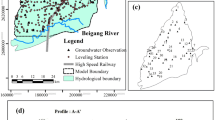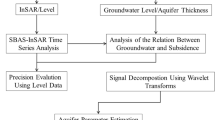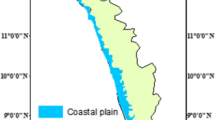Abstract
Lagos has a history of long-term groundwater abstraction that is often compounded by the rising indiscriminate siting of private borehole and water well. This has resulted in various forms of environmental degradation, including land subsidence. Prediction of the temporal evolution of land subsidence is central to successful land subsidence management. In this study, a triple exponential smoothing algorithm was applied to predict the future trend of land subsidence in Lagos. Land subsidence time series was computed with SBAS-InSAR technique with Sentinel-1 acquisitions from 2015 to 2019. Besides, Matlab wavelet tool was implemented to investigate the periodicity within land displacement signal components and to understand the relationship between the observed land subsidence, and groundwater level change and that of soil moisture. Results show that land subsidence in the LOS direction varied approximately between − 94 and 15 mm/year. According to the wavelet-based analysis result, land subsidence in Lagos is partly influenced by both groundwater-level fluctuations and soil moisture variability. Evaluation of the proposed model indicates good accuracy, with the highest residual of approximately 8%. We then used the model to predict land subsidence between the years 2020 and 2023. The result showed that by the end of 2023 the maximum subsidence would reach 958 mm, which is approximately a 23% increase.
















Similar content being viewed by others
Data availability
Not applicable.
Code availability
Not Applicable.
References
Abidin HZ, Andreas H, Gumilar I, Sidiq TP (2015) Environmental Impacts of Land Subsidence in Urban Areas of Indonesia. In: Proceeding of FIG 2015 Sofia, 17–21
Ayolabi EA, Peters DY (2005) Hydrochemical and electrical resistivity assessment of the impact of solid waste on the groundwater at Oke alfa refuse dumpsite, Lagos, Nigeria. J Sci Eng 12(1):5936–5946
Bagheri M, Dehghani M, Esmaeily A, Akbari V (2019) Assessment of land subsidence using interferometric synthetic aperture radar time series analysis and artificial neural network in a geospatial information system: case study of Rafsanjan Plain. J Appl Remote Sens 13(4):044530. https://doi.org/10.1117/1.JRS.13.044530
Balogun II, Sojobi AO, Galkaye E (2017) Public water supplyin Lagos State, Nigeria: review of importance and challenges, status and concerns and pragmatic solutions. Cogent Eng 4:1329776
Berardino P, Fornaro G, Lanari R, Sansosti E (2002) A new algorithm for surface deformation monitoring based on small baseline deferential SAR interferograms. IEEE Trans Geosci Remote Sens 40:2375–2383
Casu F, Elefante S, Imperatore P, Zinno I, Manunta M, De Luca C, Lanari R (2014) SBAS-DInSAR parallel processing for deformation time-series computation. IEEE J. Sel Top Appl Earth Obs Remote S 7:3285–3296
Chen WF, Gong HL, Chen BB, Liu KS, Gao M, Zhou CF (2017) Spatiotemporal evolution of land subsidence around a subway using InSAR time-series and the entropy method. Gisci Remote Sens 54(1):78–79. https://doi.org/10.1080/15481603.2016.1257297
Cian F, Blasco JMD, Cabrera L (2019) Sentinel-1 for monitoring land subsidence of coastal cities in Africa using PSInSAR: a methodology based on the integration of SNAP and StaMPS. Geosciences 9:124
De Luca C, Cuccu R, Elefante S, Zinno I, Manunta M, Casola V, Rivolta G, Lanari R, Casu F (2015) An on-demand web tool for the unsupervised retrieval of earth’s surface deformation from SAR data: the P-SBAS service within the ESA G-POD environment. Remote Sens 7:15630–15650
Deng Z, Ke Y, Gong H, Li X, Li Z (2017) Land subsidence prediction in Beijing based on PS-InSAR technique and improved Grey-Markov model. Gisci Remote Sens 54:797–818. https://doi.org/10.1080/15481603.2017.1331511
Grinsted A, Moore JC, Jevrejeva C (2004) Application of the cross wavelet transform and wavelet coherence to geophysical time series. Nonlin Process Geophys 11:561–566
Hill MB, Webb JF (1958) The topography and physical features of Lagos Harbour. Philos Trans R Soc Ser B 241:319–333
Hu J, Li ZW, Ding XL, Zhu JJ, Zhang L, Sun Q (2014) Resolving three-dimensional surface displacements from InSAR measurements: a review. Earth Sci Rev 133:1–17
Ikuemonisan FE, Ozebo VC (2020) Characterisation and mapping of land subsidence based on geodetic observations in Lagos, Nigeria. Geodesy Geodyn 11(2):151–162. https://doi.org/10.1016/j.geog.2019.12.006
Ikuemonisan FE, Ozebo VC, Olatinsu OB (2020) Geostatistical evaluation of spatial variability of land subsidence rates in Lagos, Nigeria. Geodesy Geodyn 11(5):316–327. https://doi.org/10.1016/j.geog.2020.04.001
Ikuemonisan FE, Ozebo VC, Olatinsu OB (2021) Investigating and modelling ground settlement response to groundwater dynamic variation in parts of Lagos using space-based retrievals. Solid Earth Sci 6(2):95–110. https://doi.org/10.1016/j.sesci.2021.03.001
Kampsax-Kruger and Sshwed Associates (1997) Underground Water Resources of the Metropolitan Lagos, Final Report to Lagos State Ministry of Works, p. 170
Landerer FW, Swenson SC (2012) Accuracy of scaled GRACE terrestrial water storage estimates. Water Resour Res 48:W04531-W4611. https://doi.org/10.1029/2011WR011453
Longe EO, Malamo S, Olorunniwo MA (1987) Hydrogeology of Lagos metropolis. J Afr Earth Sci 6(2):163–174
Natural Environment Research Council (NERC) (2003) Groundwater Quality. British Geological Survey, Nigeria. http://www.wateraid.org/documents/plugin_ documents/nigeriagroundwaterweb.pdf.13/
Olatinsu OB, Oyedele KF, Ige-Adeyeye AA (2019) Electrical resistivity mapping as a tool for post-reclamation assessment of subsurface condition at a sand-filled site in Lagos, southwest Nigeria. SN Appl Sci. https://doi.org/10.1007/s42452-018-0028-5
Olowofela JA, Akinyemi OD, Ogungbe AS (2012) Application of electrical impedance tomography (EIT) in the investigation of the impact of solid waste leachate contaminant plumes on groundwater. Academia Arena 4(6):37–47. http://www.sciencepub.net
Oyeyemi KD, Aizebeokhai AP, Oladunjoye MA (2015) Integrated and geochemical investigations of saline water intrusion in a coastal alluvial terrain, Southwestern Nigeria. Int J Appl Environ Sci 10(4):1275–1288
Rodell MPR, Houser U, Jambor J et al (2004) The Global land data assimilation system. Bull Am Meteor Soc 85(3):381–394
Scifoni S, Bonano M, Marsella M (2016) On the joint exploitation of long-term DInSAR time series and geological information for the investigation of ground settlements in the town of Roma (Italy). Remote Sens Environ 182:113–127
Shrestha PK, Shakya NN, Pandey VP, Birkinshaw SJ, Shrestha S (2017) Model-Based Estimation of Land Subsidence in Kathmandu Valley Nepal. Geomat Nat Haz Risk. https://doi.org/10.1080/19475705.2017.1289985
Terrence C, Compo GP (1998) A practical guide to wavelet analysis. Bull Am Meteor Soc 79:61–78. https://doi.org/10.1175/1520-0477(1998)079%3c0061:apgtwa%3e2.0.co;2
Tomás R, Li Z, Lopez-Sanchez JM, Liu P, Singleton A (2016) Using wavelet tools to analyse seasonal variations from InSAR time-series data: a case study of the Huangtupo landslide. Landslides, 13:437–450. https://link.springer.com/article/10.1007%2Fs10346-015-0589-y.
Yang Q, Wang Y, Zhang J, Delgado JA (2017) Comparative study of shallow groundwater level simulation with three time series models in a coastal aquifer of South China. Appl Water Sci 7:689–698. https://doi.org/10.1007/s13201-015-0282-2
Zeitoun DG, Wakshal E (2013) The subsidence phenomenon throughout the world land subsidence analysis in Urban Areas: The Bangkok Metropolitan Area Case Study. Springer, Dordrecht, pp 9–23
Zhang Y, Liu Y, Jin M, Jing Y, Liu Y, Liu Y, Sun W, Wei J, Chen Y (2019) Monitoring land subsidence in Wuhan City (China) using the SBAS-InSAR method with radarsat-2 imagery data. Sensors 19:743
Zhou L, Guo J, Hu J, Li J, Xu Y, Pan Y, Shi M (2018) Wuhan surface subsidence analysis in 2015–2016 based on Sentinel-1A data by SBAS-InSAR. Remote Sens 9:982
Acknowledgements
GRACE land data are available at http://grace.jpl.nasa.gov, supported by the NASA MEaSUREs Program. GLDAS data were received from “http://grace.jpl.nasa.gov”, which used the “Goddard Earth Sciences Data and Information Services Center”. Sentinel-1 data were processed in the framework of the GEP initiative supported by the ESA. We thank the entire GEP team, particularly Hervé Caumont, for all the supports they provided. The contributions of the three anonymous reviewers are greatly appreciated. Their contributions have greatly improved the quality of this paper. The authors thank the editor for his thoughtful evaluation of this paper.
Funding
No formal funding was received for this research.
Author information
Authors and Affiliations
Corresponding author
Ethics declarations
Conflict of interest
The authors declare no conflict of interest.
Additional information
Publisher's Note
Springer Nature remains neutral with regard to jurisdictional claims in published maps and institutional affiliations.
Rights and permissions
About this article
Cite this article
Ikuemonisan, F.E., Ozebo, V.C. & Olatinsu, O.B. Investigation of Sentinel-1-derived land subsidence using wavelet tools and triple exponential smoothing algorithm in Lagos, Nigeria. Environ Earth Sci 80, 722 (2021). https://doi.org/10.1007/s12665-021-10020-1
Received:
Accepted:
Published:
DOI: https://doi.org/10.1007/s12665-021-10020-1




